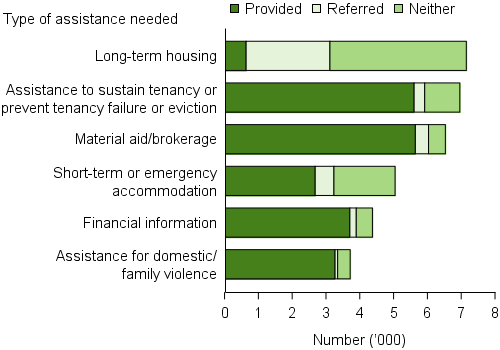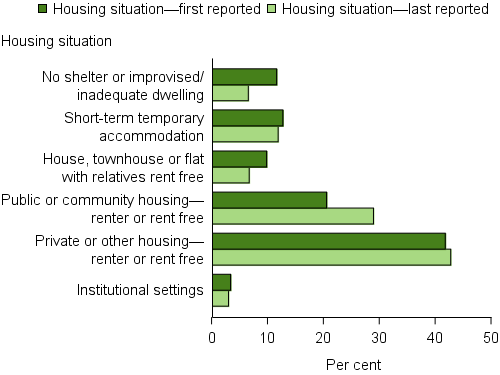Older clients
During 2015–16 people aged 55 or older comprised 8% of all clients (21,610 people) of specialist homelessness services. Specialist homelessness service use by this group is increasing quickly with numbers up 44% since the collection began in 2011–12 and growing at over twice the rate (18%) of the general SHS population.
Key findings in 2015–16
- There were about 22,000 people aged over 55 seeking homelessness services in 2015–16; an increase of 15% from the previous year, and higher than the growth rate of the general SHS population (9%).
- Fewer older clients achieved all their case management plans, down 4 percentage points compared with the previous year to 27%.
- Housing outcomes improved: Fewer older clients were homeless following support (down from 34% to 25%) with the largest decrease in the number of 'rough sleepers', down 5 percentage points to 7% at the end of support. The largest improvement in housing situation was for clients in public and community housing-up from 21% at the start of support to 29% at the end of support.
Older clients: 2011–12 to 2015–16
Since the beginning of the SHS collection in 2011–12 the number of older clients seeking assistance from specialist homelessness services has increased at a greater rate than other age groups. Key trends identified in this client population over the 5 years are:
- The rate of service use by older clients has increased from 7 older clients per 10,000 population to 9 per 10,000 (Table Older Trends.1).
- This group represents one of the fastest growing populations seeking assistance from specialist homelessness agencies. While the proportion of older clients is small (8% in 2015–16) this client group has experienced an average annual growth rate of 9.5% each year since 2011–12.
- Since 2011–12 the number of Indigenous older clients has grown at an average annual rate of 16.8% each year, with the number of Indigenous older clients reaching over 2,600 in 2015–16.
- The median number of days older clients need support has increased (from 17 days in 2011–12 to 25 days in 2015–16), suggesting these clients are presenting with potentially more complex issues, taking longer to resolve and are having greater difficulty in finding suitable housing.
| 2011–12 | 2012–13 | 2013–14 | 2014–15 | 2015–16 | |
|---|---|---|---|---|---|
| Number of clients (proportion of all clients) | 15,052 (6) | 17,193 (7) | 18,182 (7) | 18,741 (7) | 21,610 (8) |
| Rate (per 10,000 population) | 6.7 | 7.6 | 7.9 | 8.0 | 9.1 |
| Housing situation at the beginning of first support period (proportion of all clients) | |||||
| Homeless | 31 | 33 | 33 | 33 | 34 |
| At risk of homelessness | 69 | 67 | 67 | 67 | 66 |
| Length of support (median number of days) | 17 | 18 | 21 | 24 | 25 |
| Average number of support periods per client | 1.3 | 1.5 | 1.5 | 1.5 | 1.5 |
| Proportion receiving accommodation (median (nights)) | 22 | 22 | 21 | 20 | 18 |
| Median number of nights accommodated | 30 | 34 | 33 | 31 | 31 |
| Proportion of a client group with a case management plan | 47 | 42 | 45 | 49 | 50 |
| Achievement of all cases management goals (per cent) | 30 | 30 | 30 | 31 | 27 |
Notes
- Rates are crude rates based on the Australian estimated resident population (ERP) at 30 June of the reference year.
- The denominator for the proportion achieving all case management goals is the number of client groups with a case management plan. Denominator values for proportions are provided in the relevant national supplementary table.
Source: Specialist Homelessness Services Collection 2011–12 to 2015–16.
Characteristics of older clients 2015–16
55%
of older clients were female in 2015–16, similar to 2014–15.
2 in 3
older clients (66%) were aged 55–64 and the remaining one-third was 65 or over.
4%
of Indigenous clients were aged over 55 compared with 9% of non-Indigenous clients.
59%
were living alone.
21%
of older clients sought assistance primarily because of a housing crisis.
- In 2015–16, older clients were more likely than the general SHSC population to be male (45% compared with 41% of all clients). This group had a much larger proportion of lone persons compared with younger age groups.
- Older clients were less likely to be homeless on presentation than younger clients. For example, 34% of clients aged 55 and over were homeless on presentation compared with 44% of the general SHS population.
- For older clients there were 3 main reasons most commonly reported for seeking assistance: housing crisis (21%), domestic and family violence (18%) and financial difficulties (17%).
Services needed and provided
- Older clients were less likely to request accommodation services (45%) than the general SHS population (56%). However, of those who did request accommodation, most needed long-term housing (33%); they were more likely than the general SHS population to be provided with this form of accommodation (9% of those older people who requested it compared with 5% of the general SHS population).
Other services most commonly needed by older clients were for:
- assistance to sustain tenancy or prevent tenancy failure or eviction (32%, or nearly 7,000)
- material aid/brokerage (30%)
- short-term or emergency accommodation (23%) (Figure OLDER.1).
All these services were requested at lower rates than the general SHS population (assistance to sustain tenancy or prevent tenancy failure or eviction 33%, material aid/brokerage 35%, short-term or emergency accommodation 38%).
Figure OLDER.1: Older clients by most needed services and service provision status (top 6), 2015–16

Note: Excludes 'Other basic assistance', 'Advice/information', and 'Advocacy/liaison on behalf of client'.
Source: Specialist Homelessness Services 2015–16, National Supplementary Table OLDER.3.
Housing outcomes
While older clients most commonly ended their support in private or other housing (43%, or about 6,000), the proportion of older clients housed in public or community housing following support increased from 21% to 29% in 2015–16.
There was also a reduction in the proportion of older clients 'rough sleeping' (no shelter or improvised/ inadequate dwelling), falling from just over 1 in 10 clients (12%, or 1,700) at the commencement of support to 7% at the end (Figure OLDER.2).
Figure OLDER.2: Older clients, by housing situation at beginning of support and end of support, 2015–16

Notes
- The SHSC classifies clients living with no shelter or improvised/ inadequate dwelling, short-term temporary accommodation, or in a house, townhouse, or flat with relatives (rent free) as homeless. Clients living in public or community housing (renter or rent free), private or other housing (renter or rent free), or in institutional settings are classified as housed.
- Proportions include only clients with closed support at the end of the reporting period.
Source: Specialist Homelessness Services 2015–16, National Supplementary Table OLDER.4.


